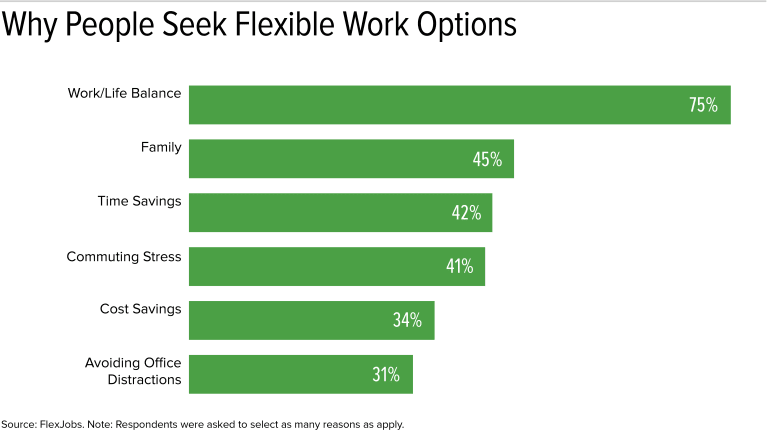Over the past few years, flexible working arrangements have quickly become one of the most popular strategies that businesses employ. With productivity, job satisfaction, and employee well-being advantages, it’s not hard to imagine why. Yet, for businesses that have only just begun the process of creating a flexible work program, it can be hard to understand the real-world benefits from the get-go.
In order to demonstrate the value of a flexible work program, companies need to be able to measure its success in terms of productivity gains as time goes on. For companies that aren’t used to making a huge change to working structures, this can pose a challenge.
Yet, considering that 58% of Americans now work from home at least one day a week, it’s more vital than ever to understand exactly how to trace the efficacy of your flexible work program. In this article, we’ll dive into the data, touching on the core metrics to follow, the best methods to use, and outlining exactly how you can demonstrate the success of your flexible work program.
Let’s dive right in.
What Are the Key Metrics and Indicators To Measure the Success of Flexible Work?
In order to measure the success of flexible work, businesses need to first understand exactly what they should be tracking. Of course, there are general improvements that flexible work could contribute to, like improving a company’s bottom line. However, something as fundamental as profit could be influenced by a number of factors, making it unreliable when proving the success of flexible work.
Instead, it’s a great idea to focus on metrics that we can directly trace to improvements in the workforce due to a more flexible approach. Here is a definitive list of metrics that your business can centralise:
- Employee Engagement and Productivity – Establishing before and after rates for employee productivity and engagement is a fantastic way of determining how your flexible work policies impact your overall workplace.
- Absenteeism – Whether it’s suffering from burnout or simply needing to take a sick day to recuperate, employee absenteeism is a common problem that costs businesses money. Flexible work can improve absenteeism, so be sure to track total sick days and attendance.
- Employee Renteion – While this is a longer-term metric, it is typically one of the leading benefits of flexible work. By tracing your employee churn over a 6-month period and comparing it to past periods, you can determine whether or not flexible work has had a positive impact on retention.
Of course, not every business will want to trace all of these metrics. However, if you want to generate a report that’s as comprehensive as possible, then this set will cover all your bases.
What methods can you use to measure the success of flexible work?
When measuring the success of flexible work, your investigations will fall into two camps: quantitative and qualitative results. The former refers to any numerical data that you can pull by comparing different periods. For example, you could trace the total amount of submitted work in one period against another or monitor sick days in one period against another.
The latter refers to written data samples, which you can get from surveying your audience. In surveys, you can ask them a mixture of open-ended and numerical questions. For example, you can ask:
- How would you rate your work-life balance considering the flexible work policy on a scale of 1-10?
- Please write a few sentences explaining your answer.
The combination of these questions will provide you with both quantitative and qualitative data, allowing your business to acquire a range of data forms for your investigation.
Although numerical data is easier to analyse, it’s important that your business does not overlook qualitative data, as your employees can share valuable feedback that helps you determine the impact of your flexible working structure.
How to use flexible work test results
Measuring the success of your flexible work program relies on being able to take the data you’ve collected and then put it to work. Typically, businesses will start with the quantitative results of their investigation, as you can create a direct analysis between current and previous data to determine the effectiveness of flexible working.
When analysing qualitative data, it’s important to collect quotes, recurring ideas, and the general sentiment displayed by your employees. While the numerical data will often show you the story, the quantitative data will paint a picture of why these changes occur. Using both forms of data in tandem will unlock a rich set of results.
When asking your employees exactly how they’re adjusting to flexible work, you’re likely to see common trends. For example, the above graph demonstrates the leading reasons that people seek and enjoy flexible working options. While not reflective of every workforce, there is a high chance that your employees will resemble a similar sentiment.
Collect your quantitative and qualitative data into a report that you can present to your higher-ups, helping to demonstrate the success of your flexible work program.
The bottom line: is flexible work worth it for your company?
There’s a reason that many parts of the world are now moving to completely flexible or offering a more varied working schedule to their employees. Flexible work, whether it’s new to you or not, is absolutely here to stay. Around 87% of employees who are offered the chance to work flexibly prefer it – and that’s not to mention the direct benefits for the employees themselves.
By meticulously tracing the outcomes of your flexible work policies, your business is able to actively demonstrate its value in terms of productivity gains, money savings, and increases in employee satisfaction. Using the strategies, metrics, and tips we’ve outlined on this list, you’ll be on track to masterfully measure the success of your flexible work program.
The future is flexible.


